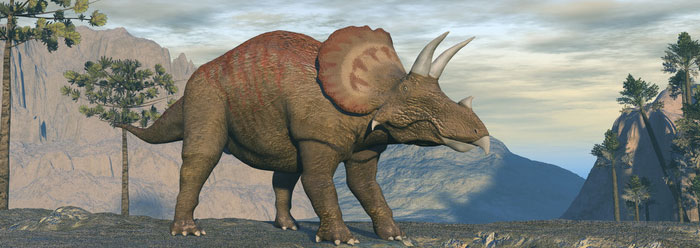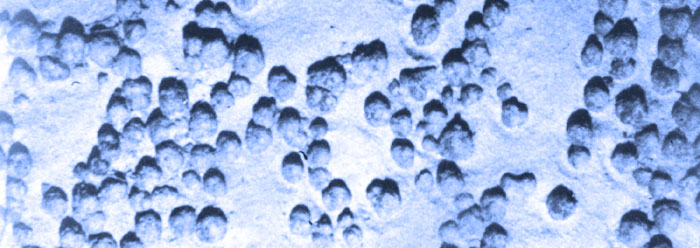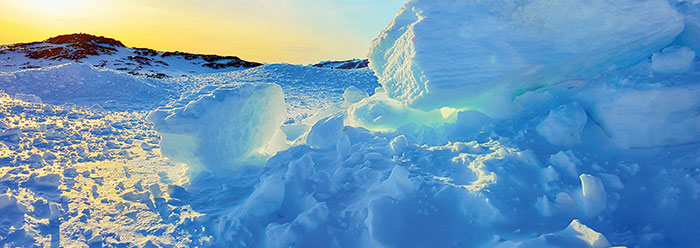Researchers continue to study one of the most well-known dinosaurs—the three-horned genus Triceratops—as they analyze data collected during the eleven-year Hell Creek Project. The effort involved collecting fossils from the famous Montana Hell Creek Formation, including over fifty Triceratops specimens. The latest report from the Project, however, reveals three logic holes in its attempts to answer questions about when and how these dinosaurs evolved.
Publishing in the Proceedings of the National Academy of Sciences (PNAS), dinosaur expert John Horner and three other scientists studied minute anatomical differences between these Triceratops specimens taken from different layers within the roughly 300-foot-thick Hell Creek Formation.
They wrote, "The combination of a stratigraphically controlled robust sample from the entire ∼90-m-thick HCF and identification of ontogenetic [maturation] stages makes Triceratops a model organism for testing hypotheses proposed for the modes of dinosaur evolution."1 Since the only hypotheses they tested were modes of evolution—ignoring any creation hypotheses—then of course they would conclude that the creatures evolved, which the study authors did.
But that's just circular reasoning—the first big hole in this study.
The report also described contradicting results of cladistics analyses where software generated likely evolutionary lineages using Triceratops anatomy details. Just because their software outputs evolutionary scenarios, does that mean Triceratops actually evolved? No it doesn't. Since the software only outputs evolutionary scenarios, it will always output evolutionary scenarios no matter how many or how much fossil detail inputs it receives! The project's software is subjective, biased toward evolution. That's a second hole.
What about the question of when these dinosaurs lived and died? The PNAS study authors wrote that the changes in horn structure that define two named species of Triceratops occurred within one to two million years. Where did they get those numbers?
They reference a technical book on the Formation published by the Geological Society of America.2 There, different evolutionary authors agreed on the rock's age using biostratigraphy. They used fossils to assign ages to rocks by assuming those fossilized creatures evolved over millions of years.
After assuming deep time in the first place, how could these researchers fail to conclude that the rock layers formed millions of years ago over a span of one to two million years?
They bolstered their age assignments by "calibrating" them to astronomical theory. The geological monograph explains, "The calibration points in both the 1992 and 1995 versions [of dates for the Hell Creek Formation] are a mixture of conventional K-Ar and 40Ar-39Ar ages and astronomical dating."2 A recent ICR article described how "calibrating" ages by assuming long ages of astronomical shifts boils down to yet another circular argument guaranteed to output millions of years.3
And if radioisotope systems involving argon or potassium really worked as accurate and reliable dating methods, then why would its users need calibration from outside sources?
This instance of circular reasoning represents the third hole in the PNAS study results, leaving plenty of room for its major conclusions to leak out.
Triceratops need not have evolved if they were simply different expressions of genetic variation that God pre-programmed into the original ceratopsid dinosaur kind. And the sedimentary rocks that contain these dinosaur fossils need not have been deposited over millions of years. The continent-covering muds and sands that Noah's Flood, or its immediate after-effects produced only thousands of years ago, readily explain these rocks and the splendid fossils they contain.
References
- Scannella, J. B. et al. Evolutionary trends in Triceratops from the Hell Creek Formation, Montana. Proceedings of the National Academy of Sciences. Published online before print, 2014, accessed July 9, 2014.
- Hicks, J. F. et al. 2002. The Hell Creek Formation and the Cretaceous-Tertiary Boundary in the Northern Great Plains: An Integrated Continental Record of the End of the Cretaceous. J.H. Hartman, K.R. Johnson, D.J. Nichols, Eds. Boulder, CO: Geological Society of America, Special Paper 361, 42.
- Hebert, J. 2014. Ice Cores, Seafloor Sediments, and the Age of the Earth: Part 1. Acts & Facts. 43 (6): 12-14.
* Mr. Thomas is Science Writer at the Institute for Creation Research.
Article posted on July 21, 2014.



























